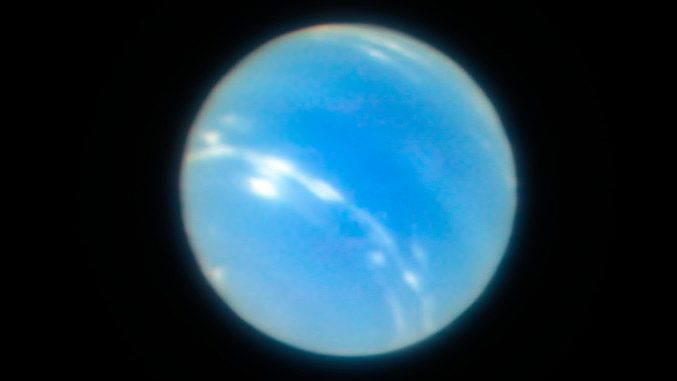
If you look in the sky to the southwest this evening after sunset (that is, on Monday, January 27, from about 6PM onward) you’ll see a very bright point of light that looks like a star. No, that’s not Neptune; be patient. That’s Venus, and you can be assured that you are actually looking at the second planet from the Sun because it will be by far the most brilliant gem in the heavens. You should be able to see Venus even from light-polluted urban areas, provided there are no clouds in your vicinity. Ordinary binoculars or a small telescope will reveal the planet as a disk and not just a point of light.
Not long before sunset in North America, but well after sunset in Europe, Venus will have appeared from an European earthling’s viewpoint to have passed very close to Neptune. (That’s right, Venus made a pass at Neptune; call the tabloids). Other than for the thrill of gratuitous gossip, why should we care? Because, dear Blenders, Venus can help us find Neptune. Throughout the night, even as Venus can be observed moving away from Neptune against the background stars, Venus will never move very far from Neptune. The Night Owl will explain further, but first a few interesting Neptunian facts:
- Neptune, the fourth gas giant planet in our Solar System, is much larger than Earth, needing nearly 58 Earths to fill it’s volume
- Neptune completes one orbit of the Sun in slightly less than 165 Earth years
- Neptune’s orbit is 30 times farther from the Sun than the Earth’s orbit
- Neptune is the densest gas giant, but also the smallest gas giant in terms of diameter
- Neptune’s vibrant blue color is attributed to a trace presence of methane in the atmosphere
- Neptune is so dense, scientists theorize that diamonds form in the atmosphere and fall into an ocean of carbon, where they float
- Pluto’s eccentric orbit brings the dwarf planet inside the orbit of Neptune, such that it’s closer to the Sun than Neptune for part of it’s trip around Sol.
Neptune, being the eighth planet from the Sun, is very far away, very dim, very blue, and very hard to find most of the time. Two hundred years ago it took about two decades to find it, even when astronomers knew where to look. In the 1820s, they noticed that Uranus’ orbit was affected by something unknown but extremely massive. Scientist already knew that the known planets of great mass (Jupiter, Saturn, and Uranus) affected the orbits of the smaller, less massive planets. Naturally, they hypothesized that there was another giant lurking out there and calculated mathematically where it should be. Neptune wasn’t finally observed and identified as the culprit behind Uranus’ perturbations until 1846. (Swell. Get to the point, already).
These days, Neptune can easily be located with astronomy software which can automatically point a telescope to the planet’s exact location in the sky. But, thanks to bright Venus brushing right by Neptune, casual backyard sky watchers can find it without fancy equipment – tonight only. Oh, uh… ahem. There’s one more tiny caveat. Neptune is too faint to be seen without at least a rudimentary amatuer telescope or a good pair of binoculars. (Ugh. I don’t have either. You made me read this far for nothing).
Well, wait just a moment. All is not for naught. If you really want to see Neptune, or Saturn and his magnificent Saturnian rings, or any other awesome object in the sky, there’s an easy and inexpensive solution. Search online for an amateur astronomy club in your area that hosts star parties. These clubs invite the public to come out at night and join them for some fun and wonder, because they want to share their enthusiasm for their hobby and want to get you interested too. They will have telescopes and computers on hand to quickly find any object in the sky, anytime, even Neptune, completely without the help of Venus. Don’t forget to bring the kids or grandchildren, it’s a great way to introduce them to science and new worlds!
Question of the night: Is Pluto a real planet, a dwarf planet, or just another Goofy dog? Let the controversy begin!
